Tadasana (Mountain Pose): Health Benefits, Types, and How to do?
What is the Tadasana/Mountain pose?
Tadasana serves to be the base for follow-up poses. In Sanskrit, ‘Tada’ represents ‘mountain’ and ‘asana’ defines ‘pose’. Hence the name, ‘Mountain Pose’. it is also known as a ‘Samasthiti’.It is an ideal position for those with weak back muscles and rounded backs as it can aid restore the body’s natural alignment. Children are often suggested to perform this asana and it can assist in increasing their height. This asana can also aid improve posture.
Mountain Pose improves your body awareness and posture, strengthens your legs, and establishes good alignment. Tadasana may not look like much, but keeping your body aligned and active is hard work. You’re not just standing in any past way. You have to be aware of every part of your body and the part that it plays in stacking your bones and keeping your spine elongated.
The primary alignment for Mountain Pose carries through to many of the other standing postures (Warrior I, or Virabhadrasana I, for example) and inverted positions (Handstand, or Adho Mukha Vrksasana) that you’re going to perform.
Which are the muscles used during Tadasana?
Muscle groups used during this pose involve the lower back muscles and stomach muscles. You also Exercise the neck, shoulders, and arms when you stand tall and decrease the desire to slouch or slump over.
What are the Health benefits of doing Tadasana Pose?
Here are some of the benefits you’ll gain once you begin practicing Tadasana:
Improves Your Posture
If you have the tendency to hunch or slouch, then doing Tadasana can be of help. When you perform this asana and do it regularly, you will observe that the back pain you felt will go away. You will know to stand tall naturally and your posture will improve.
May aid Increases Height
If you begin practicing this pose early on and stick to it, you can end up getting a few extra inches. Yes, this asana assists increase height.
Enhances Mental Awareness
Yoga is not just about motion but meditation too. This pose aids you to connect to your deeper consciousness and increases your mental awareness. You will feel calm, alert, and relaxed.
Improves Breathing
Clogged-up lungs or being unable to breathe perfectly is one of the modern-day problems we face. Tadasana expands your lungs and allows you to breathe deeply. This finishes up clearing your lungs too.
Promotes Weight Loss
If you want to lose weight then try tadasana. Your metabolism will improve and you will burn calories quickly.
Enhances Energy Levels
Another advantage of the mountain pose is that it helps boost energy levels. This is because it refreshes the mind, body, and soul.
Improves Your Mood
If you’ve had a bad day, then do Tadasana. It can aid beat depression and strengthen the nervous system. Your memory will boost and you’ll be able to concentrate on matters that need attention.
Provides Relief From Sciatica pain
If you’ve got sciatica, Tadasana will aid provide relief from the sciatica pain. And it also assists prevent it from happening in the future.
Tadasana maybe helps in treating health conditions such as:
Parkinson’s disease. Tadasana aids with Parkinson’s disease by gaining lower body strength and improving posture and balance.
Ankylosing spondylitis (AS). Mountain pose is a gentle option to decrease pain related to AS. It also assists to improve posture and improve flexibility.
Chronic obstructive pulmonary disease (COPD). The emotional and physical advantages of Tadasana are helpful for people with COPD. It can relieve stress and anxiety while building balance and strength.
How to perform Tadasana/Mountain pose?
In a Standing position/Mountain pose
- Take a standing position with your big toes touching.
- Raise up all of your toes and fan them out, then drop them back down to form a wide, solid base. If your ankles are knocking together painfully, then slightly separate your heels.
- Let your feet and calves root down into the ground.
- Engage your quadriceps and move them upward, causing your kneecaps to arise.
- Rotate both thighs inward, forming a widening of the sit bones.
- Keep the natural curves of your spine.
- Tone your belly, moving it in slightly.
- Widen your clavicles and check that your shoulders are piled over your pelvis.
- Shrug your shoulders up to the ears and then roll them backward to release your scapulae down your back.
- Let your arms hang comfortably
- by slightly bending the elbows and the palms facing forward.
- Your neck is long, your chin is neither tucked down nor raised up, and the crown of your head rises toward the roof.
- Once you have checked all your positioning points, take 5 to 10 breaths while you hold yourself in this pose.
How to do Tadasana by using a video presentation?
In a Supine Position/Reclined Mountain Pose
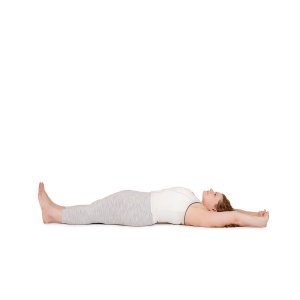
This supine mountain pose is also famous as the Supta Tadasana.
Follow the below step to do the Reclined Mountain Pose :
- Take a supine position on a yoga mat and put a towel under the crown of your head straight and use two to three towels as props that you can use under your knees.
- Now lie down and recline using these props to gain your natural arch.
- Now lift your arms and take them over your shoulders. Stay in this pose for five or ten minutes.
- Breathe in and out for six counts each and get up slowly.
What is the variation of the Mountain pose?
Tadasana Variations:
Below are some common variations of the yoga pose Tadasana with the base pose as Mountain Pose (Tadasana).
- Tadasana Gomukhasana (Standing Cow Face Pose)
- Tadasana Paschima Buddha Hastasana (Back Bound Hands Pose)
- Tadasana Paschima Namaskarasana (Standing Reverse Prayer Pose)
- Volcano Pose (Urdhva Hastasana, Tadasana Urdhva Hastasana)
- Five Pointed Star Pose (Utthita Tadasana)
- Indudalasana ( Half Moon Pose)
- Namaskarasana
- Anuvittasana or Hasta Uttanasana (Standing Back Bend)
Tadasana Gomukhasana (Standing Cow Face Pose)
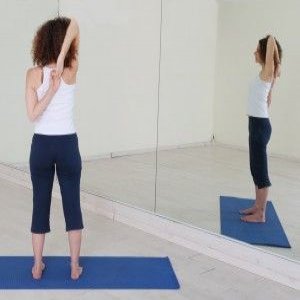
What is Tadasana Gomukhasana ?
The standing cow face pose, or tadasana gomukhasana in Sanskrit, is a combination of a mountain pose and a cow face pose.
How to do :
Start standing with the feet hip-distance wide.
Inhale and reach the left arm up, then flex the elbow to bring the hand behind the back.
Exhale and reach the right arm behind the back and flex the elbow.
Grasp the hands.
Breathe while holding the position.
Breathe in and release. exchange sides.
Benefits of Standing Cow Face Pose :
- Opens the chest.
- Increases respiration and circulation.
- Strengthens the core muscles, legs, back and arms.
- Improves posture.
- Enhances energy.
- Enhances confidence and helps to treat depression.
- Eases cervical spondylosis
- Decreases sciatic pain
- The stretch in the arms assists relieves arthritis in the shoulders, elbows, wrists, and fingers.
- It helps in correction in the flat feet.
Contraindications and Cautions :
- If it’s not possible to grasp the hands, hold on to a strap to prevent overstretching the shoulders.
- Stress-related headaches
- eye strain
- Migraines
- low blood pressure
- insomnia
- Leukorrhea
- Osteoarthritis of the knees
- Diarrhoea
- If you have backaches, a displaced uterus, a slipped disc, or pain in the wrist, keep your big toes together and your heels slightly apart.
Tadasana Paschima Baddha Hastasana (Back Bound Hands Pose)
What is Paschima Baddha Hastasana?
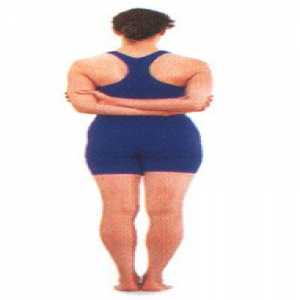
The Sanskrit word paschima baddha hastasana defines as “hands folded at the back.”
Baddha means “caught” or “bound”.
This asana is a simple version of Tadasana.
Paschima namaskarasana assists to prepare you for the regular pose, which calls for more flexibility and extension of the back and arms.
How to :
Keep your head erect and stretch the neck without tensing the muscles.
Keep the shoulders straight and do not raise them.
Keep your spine erect but do not strain it.
Keep your arms straight and bend them behind your back.
Raise your upper body and broaden your chest.
Draw your lower abdomen in and up.
Move your hips and buttocks inward by compressing them.
Keep your feet together and press your heels firmly against the floor.
Benefits of Paschima Baddha Hastasana:
- Enhances confidence and helps decrease depression.
- Aids in the treatment of cervical spondylosis.
- Reduces arthritis of the shoulders, arms, wrists, and fingers.
- Strengthens the knee joints.
- Relieves sciatic pain.
- It helps in the correction of flat feet.
Contraindications and Cautions:
- Angina
- Stress-related headaches
- Migraines
- Low blood pressure
- Eyestrain
- Insomnia
- Leukorrhea
- Bulimia
- Osteoarthritis of the knees
- If you have a displaced uterus, draw the tips of your big toes together and your heels apart.
- If you have a slipped disk, move your feet apart.
- If you have had polio, or have any issues with your balance, keep your feet at least 25 cm apart.
Tadasana Paschima Namaskarasana (Standing Reverse Prayer Pose)
What is Tadasana Paschima Namaskarasana ?
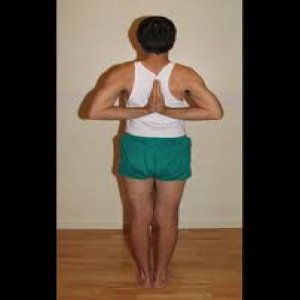
In this standing asana, the hands are flexed at the back in the Indian salutation of namaskar or “greeting.”
This stretch needs considerable flexibility in the upper body and arms.
Practice Paschima Baddha Hastasana until your shoulder, elbow, and wrist joints are sufficiently supple to do this asana easily.
How to do :
Start in the Tadasana pose.
Relax the shoulders and fold your knees a little.
Draw your arms behind your back and fix the palms with fingertips facing downward.
As you breathe in, turn the fingertips inwards towards the spine and draw them to face upwards.
Assure that the knees are still slightly flexed and the palms are pressed firmly against each other.
Stay in the pose for a few breaths.
As you breathe out, slowly turn the fingertips downward.
Draw the arms to the side of the body and slowly return into Tadasana.
Benefits of Tadasana Paschima Namaskarasana :
- Decreases depression.
- Reduces cervical spondylosis.
- Improves the flexibility of the upper body, arms, elbows, and wrists.
- Strengthens the knee joints.
- Decreases sciatic pain.
- It helps in the correction of the flat feet.
Contraindications and Cautions:
- Stress-related headaches
- Diarrhoea
- Low blood pressure
- Migraines
- Insomnia
- Leukorrhea
- Bulimia
- Osteoarthritis of the knees
- If you have high blood pressure, do not hold the position for more than 15 seconds.
- If you have had polio, are knock-kneed, or have an issue with your balance, keep your feet 20 cm apart.
- If you have backaches, slipped disk or a prolapsed uterus, maintain your feet together and knees apart.
Volcano Pose (Urdhva Hastasana, Tadasana Urdhva Hastasana)
How to do :
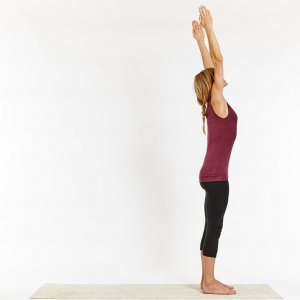
Stand with your big toes touching and a minor space between your heels. Root down with your big toe piles, your heels, and the outside edges of your feet. draw up with your inner arches.
Rotate your inner thighs back and slowly release your tailbone toward your heels.
Pull your shoulders back, soften your front ribs, and mound the crown of your head above your pelvis, lifting your chin parallel to the ground.
Lift your arms overhead with your hand’s shoulder distance apart and palms facing each other.
Draw your arms in a row with your ears. Rotate your biceps backward and let your shoulder blades move up and out away from your spine.
If you’re able to keep your arms extended, reach up and touch your palms, bringing your look to your thumbs.
Take a few breaths, then release your arms.
Volcano Pose benefits :
- As a belly-stretching position, Upward Salute can aid improve your digestion.
- Urdhva Hastasana stretches the sides of the body, shoulders, spine, armpits, and belly.
- It tones the thighs, increases digestion, and helps to reduce anxiety and fatigue.
- It also assists to create space in the chest and lungs, which is therapeutic for asthma and congestion.
Five-Pointed Star Pose (Utthita Tadasana)
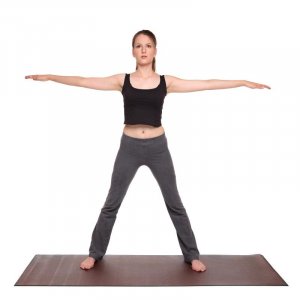
How to do :
From the Mountain pose, draw the feet wide apart, with the arms out to the side. The feet should be below the wrists, facing forward and parallel.
Press your weight into the feet, pull up the knees and squeeze the thighs, tuck the tailbone, and feel your legs strong and solid, rooted into the ground.
Reach out through the fingertips, attempting to touch the side walls. Relax the shoulders down and back, slowly opening the chest towards the front of the room.
Inhale and press the crown of the head up towards the roof. Look straight ahead with the chin parallel to the ground.
Breathe in deeply into the belly and chest, breathe out press into the feet, fingers, and crown, feeling the body expanding out in 5 directions.
Continue breathing and hold for 4-8 breaths.
To release, flex one knee and step back into the mountain pose.
Five-Pointed Star Pose (Utthita Tadasana) Benefits :
- A five-pointed star lengthens, opens and energizes the entire body. This posture also readjusts the spinal column and opens the chest, increasing circulation and respiration.
- Base pose for all standing Poses.
- Strengthens the balls of the feet and heels.
- Strengthens the shoulders and arms muscles.
- Strengthens the lowest part of the backbone.
- Increases the balance of the body.
- Improves the concentration with awareness when holding this pose for longer counts.
- Activates the Muladhara (Root) chakra and Svadisthana (Sacral) chakra.
- Opens the chest using the rib cage muscles perfectly.
- Good for increasing the flexibility of the joints.
- Improves posture.
Indudalasana ( Half Moon Pose)
What is Indudalasana?
Indudalasana is a standing asana that opens the sides of the body. The name of this posture comes from the Sanskrit indu, which represents “moon”; dala, defines “portion of” or “fragment”; and asana, which means “pose” or “posture.”
How to do :
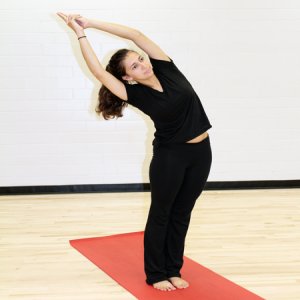
Start with Tadasana / Mountain Pose.
Breathe in and move your arms towards the roof while expanding your upper ribs.
Join your palms and keep your back erect.
Exhale and bend towards your left without disturbing your lower body.
Feel the stretch on the right side of your body.
Look forward and keep your balance.
Stay in this position for 3 long breaths.
Breathe in and come back up.
Exhale and repeat the posture on your right side.
Indudalasana Benefits :
- Relieves stress and fatigue.
- Stretches the sides, arms, shoulders, and spine.
- Strengthens your abdominal muscles.
- Increases digestion.
- Increases flexibility and balance.
- Increases blood circulation.
Namaskarasana, Pranamasana, or Prayer Pose has the hands in a prayer position (Anjali mudra) in front of the chest.
Anuvittasana or Hasta Uttanasana (Standing Back Bend), has the arms lifted and the back arched.
What are the Modification options for Tadasana pose?
There are several ways to modify Tadasana. Modifications bring ease to the position, adapt to individual differences, and offer variety. Some modification points for Tadasana include:
- Use a chair to perform seated Tadasana, which improves posture and boosts core strength. It also helps to adjust your neck, shoulders, and spine.
- If you are pregnant or have tightness in your low back, knees, or hips, stand with your feet hip distance apart. This foot the position makes it easier to balance and may feel more comfortable.
- Check your balance by closing one eye or both eyes. Or turn your look upward.
- Check with arm variations and pay attention to how they alter your alignment.
- To get a feel for perfect alignment, perform Tadasana with your back against a wall. Slowly press your scapulae, sacrum, and backs of heels into the wall.
- To improve body awareness, play with your balance and weight distribution. Shift your weight forward and backwards.
- Then shift your weight into the insides and outside of your feet. Next, balance on the toes of your feet and then on your heels. Notice how these transfers affect your overall posture, balance, and alignment.
What are the Common Mistakes done during the Tadasana pose?
Though this seems rather straightforward, there are mistakes that many people often make that are worth being aware of.
Rushing Through Tadasana
Since this pose looks so simple, there is a temptation to ignore its importance or rush through it. Instead, make sure you get in at least one really attentive Tadasana at the start of each practice. It’s a good way to check in with your body and set yourself up to be mindful of your form throughout all your poses.
Thigh Rotation
If you are a beginner, you can boost the right body awareness in Tadasana and assure you are rotating your thighs inward by placing a block between them. The block should be rotated so that the short end faces the front. Press the block with your legs and roll it slightly backward to feel the engagement and rotation of the thighs.
Take e few breaths this way. Then remove the block, but imagine the action of your thighs as if the block was still there. You don’t have to apply the block every time, but doing so assists your body to remember how to rotate the thighs inward.
Alignment
You can check your alignment in the mountain pose by gazing in a mirror if it’s available. Check to see if your shoulders are piled directly over your hips and your hips are piled directly over your feet. Think how all of your joints are piled on crowns of each other from ankles to shoulders.
What is the Contraindication for Tadasana pose?
There are some Contraindications for Tadasana (Mountain Pose):
Injury and Surgery: Tadasana (Mountain Pose) should not be performed by people with knee and ankle injuries. It should also be not done by people who have undergone knee, hip, and spinal surgeries. This pose needs standing for some time and this is hard for such people and may further cause damage.
Absence of Body-Breath Connections: Beginners may find it hard to even stand straight with their feet close to each other. People who lack breath body connection can perform this pose with the yoga teacher’s guidance. Either they can begin with Mountain Pose Variation.
Physical Strength and Weak Body: Students with weak knees and ankles should not do directly get into Tadasana (Mountain Pose). The yoga teacher needs to teach them about knee and ankle strengthening and then start the pose. Seated Ankle Rotations (Upavistha Golf Chakra) is a good ankle strengthening position and Seated Knee Bending will strengthen their knees. People with vertigo, a migraine, and low or high blood pressure also shouldn’t do this pose. Such ailments cause dizziness and this position can bring more discomfort or pain if the balance is a challenge. Knee locking can be daring for some people and the yoga teacher can teach them with Knee Exercise Knee Cap Pulled Close Up.
Others: Senior citizens and Pregnant women have balancing problems. Pregnant women may feel over-weighted, due to the load of the womb and seniors due to weakness, etc. Mountain Pose Variation Feet Hip Wide (Tadasana Variation Feet Hip Wide) or Mountain Pose Wall (Tadasana Wall) are the best alternatives for them. The balance improves with wider feet and the wall support is encouraging and supports the back.
Therapy and Restorative: Though Herniated Discs, Scoliosis, and Kyphosis spinal disorders can be treated by this pose, yoga teachers require to rule out vertigo, migraine, and low or high blood pressure in such patients to prevent falling due to imbalance. Such patients can be encouraged to perform seated spinal exercises.
The Bottom Line
While Tadasana is one of the most fundamental yoga asanas, it provides a challenge for all levels and offers several physical and emotional advantages.
Tadasana centers your body and mind, which aids create a calm sense of inner peace.
Keeping alignment and body awareness is a constant process. Standing strong, steady, and centered in Mountain Pose assists to improve posture, alignment, and balance. This can advantage other yoga poses as well as your daily motions.
Keep your practice fresh by continually thinking of ways to vary the position.

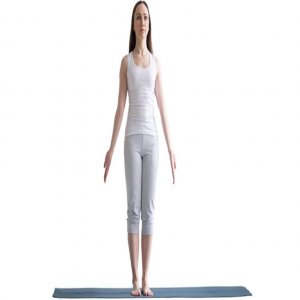
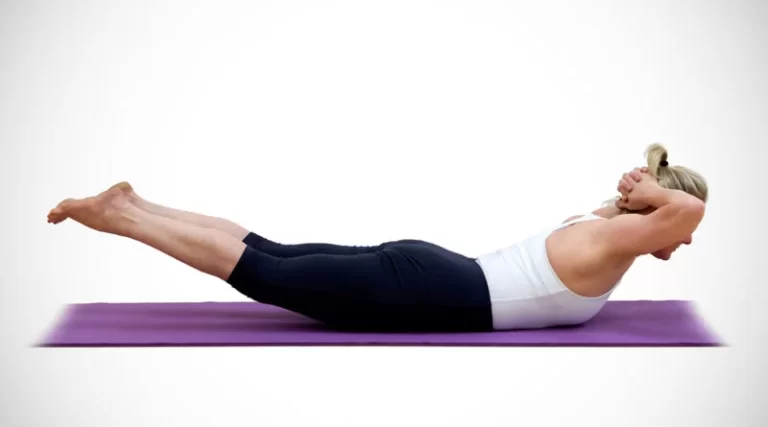
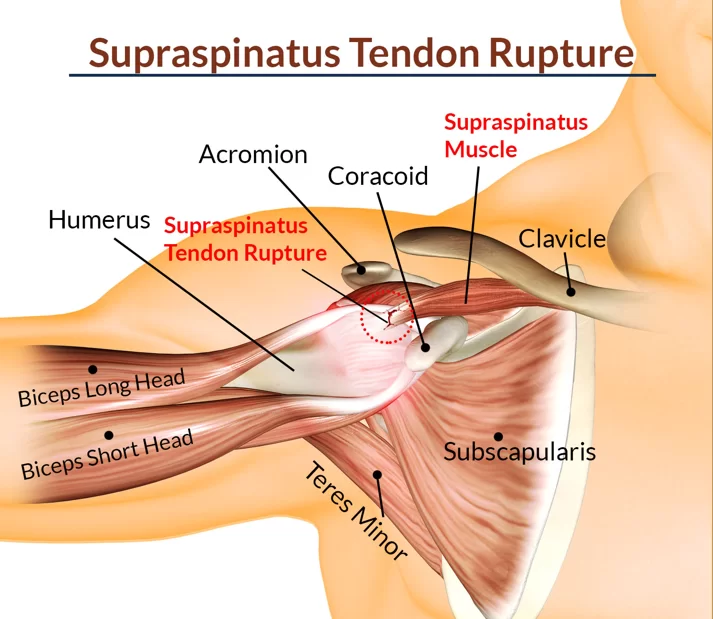

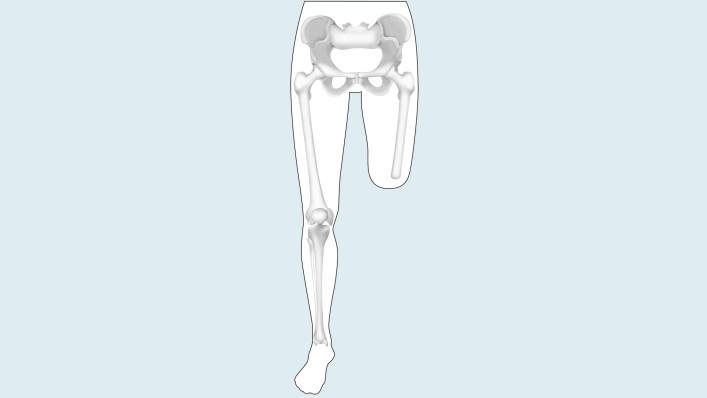
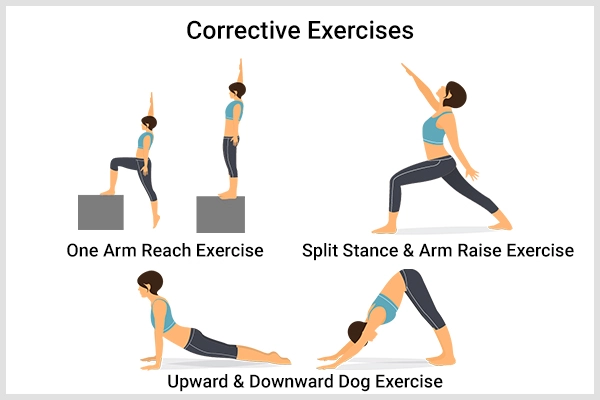
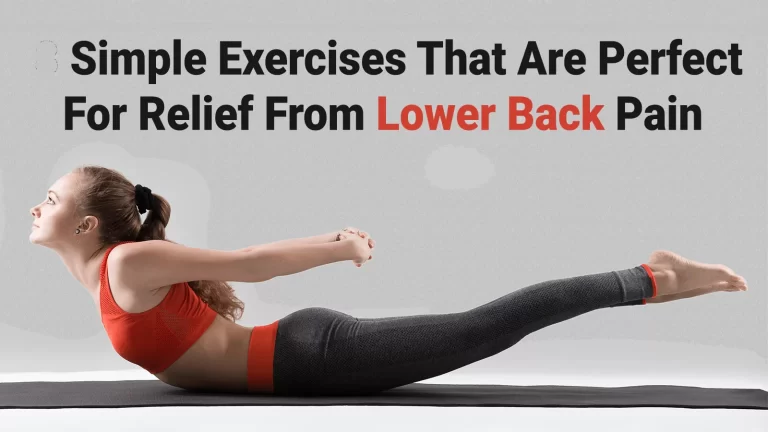
9 Comments